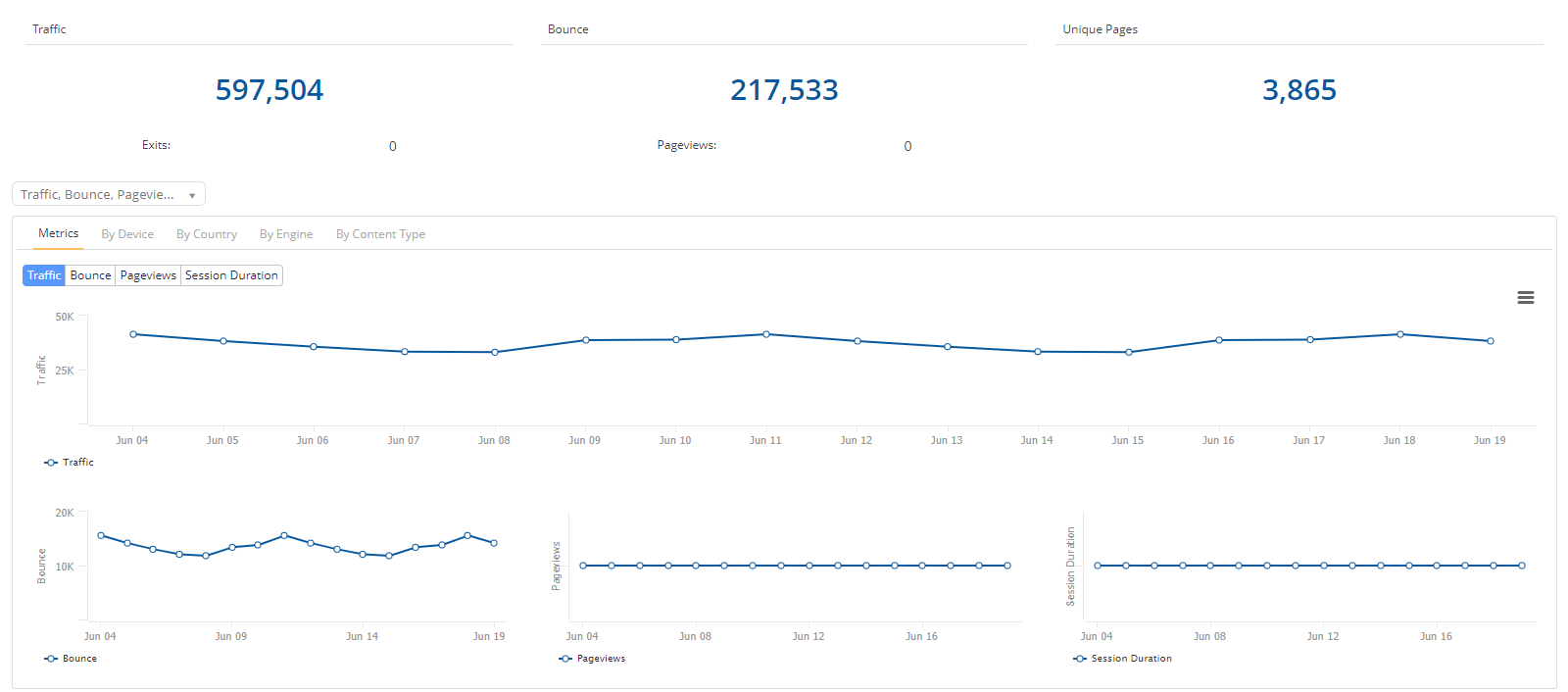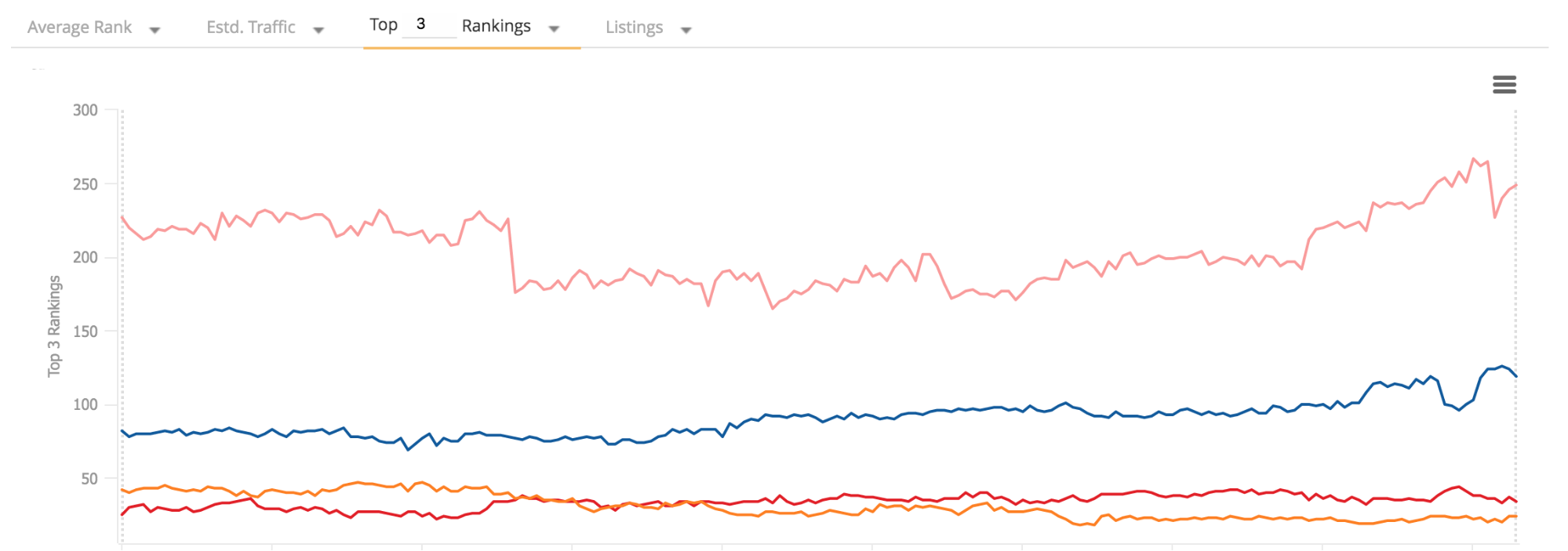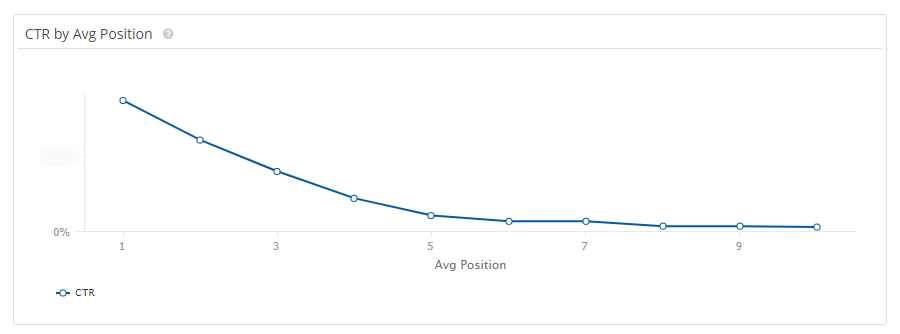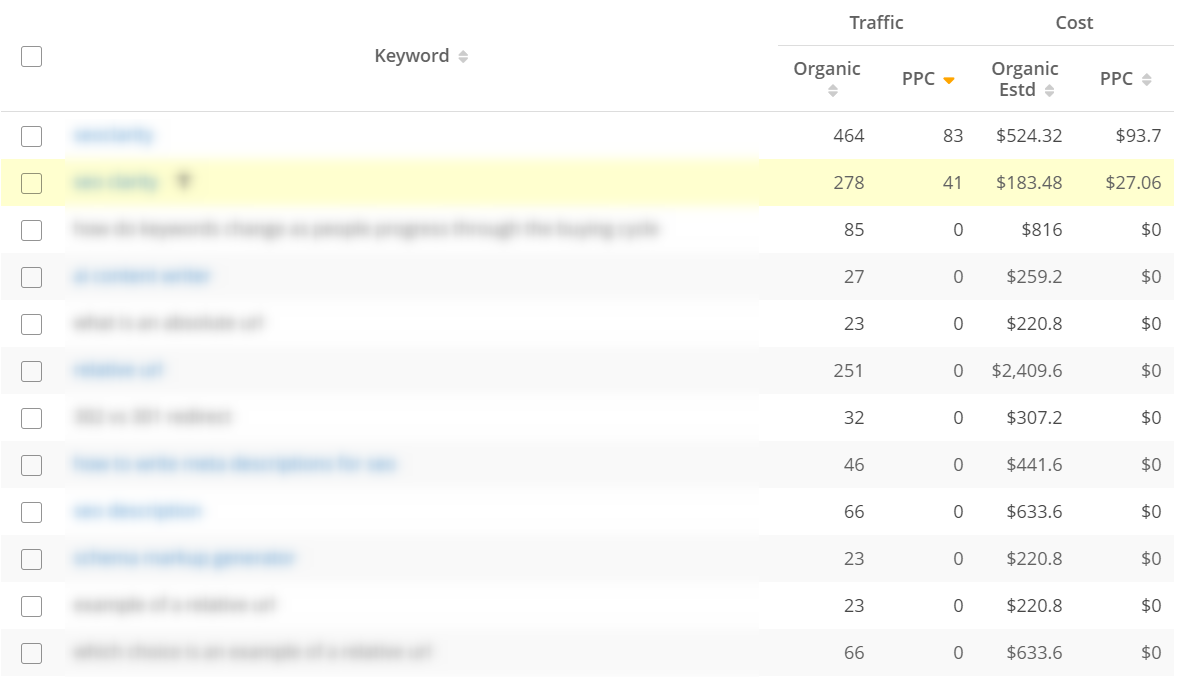Measuring the impact of SEO strategies is critical to achieving SEO success. After all, that's how you discover whether your ideas have worked and what results you are delivering to an organization.
While it can be nuanced, it's not rocket science! SEOs shouldn't shy away from measuring progress over time and it's not as daunting as you may have been trained to believe. All you need are the right resources and an idea of what to consider in each SEO campaign.
How do you measure SEO progress and analyze your results? In this guide, you’ll learn the various SEO metrics and KPIs to track your progress and see how to use an enterprise SEO platform to easily retrieve and analyze that data. I have also included use cases where each metric applies.
All you need is a little patience, some elbow grease, and your favorite SEO tool or platform. In this post, we use our technology to cover:
- Why Tracking SEO Progress is Challenging
- How to Measure SEO Progress Using an Enterprise SEO Platform
Why is Tracking SEO Progress So Challenging?
I have yet to meet an SEO who hasn't struggled with measuring the progress of their SEO strategies at some point in their career.
Some find it hard to identify one metric that confirms a success (or reveals a failure). As a result, they cannot pinpoint the exact cause of the campaign’s performance.
For others, processing vast amounts of data has resulted in losing track of what they wanted to measure in the first place.
In truth, both groups approach tracking SEO progress incorrectly.
One big challenge with measuring SEO, I’ve found, comes from the fact that we try to analyze SEO as a whole. We try to identify that single metric that would immediately reveal success.
SEO doesn’t work like that. Much of the time, your work consists of working on multiple separate projects. It might be optimizing landing pages for a new product line or fixing technical issues on the site. You could be focusing on improving rankings for a group of keywords, building links to promote a specific content asset you want to push higher in Google, and so on.
It’s impossible to prove each of those projects’ successes at once. For that reason, finding a single metric to track your progress is impossible.
Using multiple KPIs simultaneously might not work either. Well, not unless you attach them to individual projects.
So, what’s the solution? Identify individual tracking criteria for each project, which will tell the story of your SEO progress in regular reporting. You can measure these criteria and your SEO progress using an enterprise SEO platform like seoClarity, as outlined below.
Recommended Reading: Reporting SEO: How to Take SEO Reports to the Next Level
How to Measure SEO Progress Using an Enterprise SEO Platform
The following is a list of the most important SEO success metrics that help SEOs track progress in their SEO strategy. Each helps to evaluate how well your different projects have worked out. I’ve also suggested additional content to help you learn more about each metric and the area of SEO it monitors.
Finally, for each metric, you’ll also see how to gather and analyze that data in an enterprise SEO platform. Use the jump links below to scan the list with ease.
#1. Measure Growth of Organic Search Traffic
By far, this is the strongest indicator of your SEO campaign performance and progress over time. Month-over-month organic traffic growth signifies that whatever initiatives you’ve launched - be it targeting new keyword groups, improving on-page SEO, or publishing new content, for example - are working. Your rankings are going up, and you expand the organic reach and search visibility.
When to Use:
- To prove the overall SEO success.
- To confirm the success of any projects aiming directly at increasing rankings for specific keywords.
Measuring organic search traffic is one of the easiest and most relatable ways to convey progress of your SEO campaigns across your organization. You can monitor your progress within a free SEO tool like Google Analytics.
Within an enterprise SEO platform like seoClarity, users can visit the Traffic Potential view to see the following metrics as a way to track overall progress:

Each metric pictured above shows the progress related to organic search traffic. Clients can modify the variation models within the platform to track various goals related to their forecasted traffic.
Further Reading:
#2. Determine the Percentage of Organic Traffic in Overall Traffic to the Site
Monitoring the percentage of organic traffic in the overall website’s traffic helps you determine the important aspects of your SEO strategy. You can use it to evaluate your performance against the market and identify whether you’ve been gaining or losing the market share.
Similarly, with the metric, you can evaluate your overall digital marketing strategy and answer questions about each channel’s performance.
Finally, this metric also reveals the overall impact of SEO on the organization and may help convince stakeholders to new ideas or initiatives.
When to Use:
- To identify the impact of SEO on the company’s overall marketing strategy.
- To identify the organic market share.
Site Analytics is a simple way to do a powerful, ad hoc analysis on all organic search data. Users must first integrate their Google Analytics data into the platform.

From there, Site Analytics helps:
- Easily compare year over year organic search performance.
- Analyze analytics data by dimensions (device, country, search engine or page content types) to identify areas for improvement.
- Correlate analytics data with other SEO metrics like Rankings, Bot Activity, page issues, Search Console keywords, and so on
Further Reading:
- The Key to Reporting SEO When You Manage Multiple Domains
- Using SEO Forecasting: How to Build an SEO Business Case
- How to Gain Buy-In with an Enterprise SEO Dashboard
#3. Track Your Keyword Rankings Over Time
I admit that ranking data isn’t ideal to signify SEO progress. With frequent algorithm updates, and Google ranking fluctuations, there are too many challenges associated with tracking rankings and relying on this metric to show consistent, valuable progress.
Tracking rankings can, however, deliver so many other insights that you require as an SEO.
Monitoring rankings can help identify and troubleshoot traffic drops, after all. Rankings can also help spot new opportunities, like a keyword’s potential to trigger an answer box, for example. Finally, the ranking data will help you spot problems with the organic click-through rate and even spy on your competitors’ performance.
When to Use:
- Exploring changes in search visibility
- Planning content opportunities
- Comparing your domain vs. a competitor domain and how you are progressing in competing for a particular keyword
There are many ways in which you can approach keyword ranking data, and an enterprise SEO platform helps you do the most with this information. We have covered why it's important to track your rankings in the past, but for the sake of demonstrating progress of your SEO campaigns, you'll want to refer to Rank Intelligence.
Using your keyword ranking data, you can show how many keywords have started to rank since your last report, at which positions, and how much traffic and sales those ranking keywords impacted the associated pages.
You can also report on the performance change over time to illustrate your overall progress, like the number of keywords that have moved up from positions 3-5, for example, or how many jumped to page one from page two, and so on.

(Rank Intelligence dashboard widget for reporting in seoClarity which shows the amount of top 3 ranking keywords.)
Further Reading:
#4. Monitor Organic Click-Through Rate
Organic click-through rate (CTR) reveals how many clicks your search listings have received, and allows you to evaluate your content’s performance in Google. Because let’s face it, a page with good rankings should receive a decent organic CTR, unless it fails to engage search engine users.
Monitoring organic CTR helps you identify the overall performance of the site and its individual pages against their target keywords, and identify assets to improve.
When to Use:
- To track performance of an organic listing
- To view the CTR of your homepage vs. the rest of your site
- A/B testing on various site pages.
While Google Search Console provides CTR data based on the following formula:
Clicks/Impressions*100
... determining the CTR is quite manual. With seoClarity, we’ve completely automated this process. You don’t have to do any exports to get your CTR data. We do this through Search Analytics where you can see the CTR by Average Position graph, as shown below.
Once you have identified the CTR by average position, you can take this data to update the CTR index. The data can then be aligned with your industry’s click-through rate data (assuming you've integrated your GSC data into the platform).

Further Reading:
- How to Find Your True CTR in SEO (And What to Do With It)
- My Rankings Haven't Dropped but My Organic CTR Tanked - Help!
#5. Track Your Organic Conversions
Tracking organic conversion tells you how many of your total organic visitors convert into leads or customers, depending on your company’s goals. The metric will also help you evaluate the quality of organic traffic, allowing you to establish whether your projects or campaigns attract the right audience, if you’re targeting the right keywords, and focus on the exact intent people you want to attract to the site have.
When to Use:
- Tracking campaign progress
- Determining your target audience
- Understanding your best-match keywords that convert
There are many ways in the platform to understand conversion rate, but none is more telling in my opinion than the PPC vs Organic view of your ranking keywords. Once you determine where the opportunity lies, you can focus your attention in the areas where improvements are needed to improve conversions. 
Further Reading:
#6. Narrow Your Focus on Engagement Metrics
To rank, your content must include more than just excellent information, coupled with strong on-page optimization. It must also engage visitors and provide value to the very people you want to attract. Otherwise, they’ll bounce off the page. And the more of them that do that; the less likely Google will be to consider your content valuable.
But how does the search engine know what user experience your content provides? And how can you measure the same?
That’s when engagement metrics come into play. The term encompasses various data points that relate to the customer’s engagement with the content. The most common engagement metrics in SEO are:
- Bounce rate,
- Time on page,
- Pageviews during an individual session,
- Scroll depth, and
- New vs. returning visitors.
When to Use:
- When determining how to keep your readers' attention
- When focusing on site errors that might deter your audience
Our latest Actionable Insights release leverages machine learning to help users analyze and identify SEO content marketing opportunities. In the report below, users can track areas where they can make changes or updates to improve usability, relevance, and authority across their site.
Further reading:
- Next Generation Actionable Insights: AI Analysis in SEO
- Why You Struggle to Write Engaging SEO Driven Content
#7. Examine Your Link Profile Growth
Although links aren’t as critical to SEO success, they still help. Everything else being equal, a domain with a stronger link profile will, most likely, gain better rankings.
Monitoring backlinks growth will give you a general idea of how well your campaigns are progressing over time. If your healthy links are increasing, then it's likely that your SEO strategy is progressing positively. It can also signify the success of various content-based projects, particularly those aimed at acquiring more organic backlinks.
When to Use:
- To prove the value of link building projects,
- To determine the success of various content-based projects.
We've previously written about expanding your link profile in the resources listed below. The two best ways to do this are by sourcing new links in your existing link profile and expanding your link profile with new mentions and backlinks.
Further reading:
- Link Profile Analysis: How to Maintain a Clean Backlink Profile
- 4 Strategies to Build More Backlinks Using Your Current Link Profile
#8. Maintain Your Site’s Technical Health
For Google to rank your content, it must be able to find, crawl, and index it first. Unfortunately, many technical elements - from broken links, poor navigation structure to crawl errors, page speed issues, and more - can prevent Googlebot from accessing various content.
When to Use:
Monitoring the overall site’s technical health through regular site audits will help you:
- Eliminate technical SEO issues before they become problematic,
- Monitor the site’s growth and performance,
- Showcase your progress in improving the site’s health and performance.
The additional resources below will set you on your way to optimal site health. Want to perform a quick site audit? We've got you covered. Looking for a more thorough approach? We offer that as well. Assuring your site is technically healthy is the best footing you can give to track your SEO campaign progress. Without a healthy site, you're charting a course that could lead to a lot more work than you set out to do in the first place.
Further reading:
- Got 15 Minutes to Spare? Perform This Quick SEO Audit
- A Guide to Crawling Enterprise Sites Successfully
- The Best SEO Audit Checklist to Boost Search Visibility and Rankings
Final Thoughts
To achieve SEO success, you must continuously measure and track your progress. That’s how you discover whether your ideas have worked, after all, and what results you’ve delivered.
In this guide, I’ve shown you the most critical metrics of SEO success:
- Organic traffic growth,
- Percentage of organic traffic
- Rankings
- Organic conversions and the click-through rate
- Engagement metrics,
- Link profile growth, and
- Technical site health.
Use them to track the success of various SEO projects you’re running, confirm the value of SEO to the organization, and the impact you’re delivering.



.png?width=140&name=Untitled%20design%20(10).png)



Comments
Currently, there are no comments. Be the first to post one!